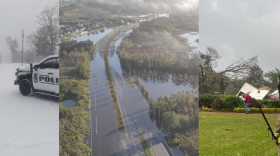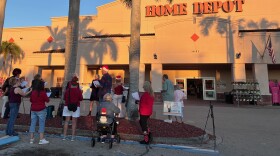Researchers at the University of Florida's Institute of Food and Agricultural Sciences are trying to measure how the toxic algae in 2017 and 2018 affected local tourism.
WUSF's Bradley George spoke about the the long-term economic effects of the outbreak with UF assistant professor Christa Court. Below is a transcript of their conversation.
What are the main takeaways from your research?
I think the top line is that we were finally able to provide some estimates on how local businesses are impacted. Even though these harmful algal blooms are dynamic, they're changing, they get stronger and weaker, and they affect a part of the county but not the entire county. So often data sources don't allow us to tease those out. But via survey, we were able to show that there are significant impacts on the for hire charter, fishing and dive services as well as marine recreation. And then we were able to use other data sources to show that there is a significant impact, at least in the short term on tourism. And we looked at that via Airbnb data.
What did you find in that Airbnb data?
We found changes in both price and reservation days. When there is a red tide bloom locally present, there is a decrease in price. And there is also a decrease in reservation days. Either people are canceling trips, or maybe they make a trip shorter, they're not willing to pay as much to come to a vacation that they may not be able to enjoy as much as they want it to.
Were you able to get data about hotels, restaurants?
No, we don't have that yet. The reason that we use the Airbnb data is we were able to get daily information. The information that we have on things like hotels or restaurants, at least that is publicly available, is often only reported quarterly or annually. And again, since these events come and go, at least in a particular area, it's hard to find an effect that's not masked by other activities. If you think of a particular county that the coast might be impacted by a red tide event, then if a visitor still comes, they might still spend money within that county, just not along the coast. So if we don't have data that are fine scale enough in terms of location and time, then it's much harder to analyze these impacts and attribute them to harmful algal bloom.
Anything in the data that surprised you?
I don't think so. As part of this project, we went down and talked to local community members prior to embarking on the project to see what, as a local, did they experience during this particular event. What we ended up finding in the data matched a lot of what we heard in those conversations.
How do you think this research will help communities deal with the economic effects of future algae bloom outbreaks?
I think a lot of communities are mulling over decisions as to whether or not they should spend money to prevent these events or mitigate the impacts of these events. And it's hard to do a complete cost benefit analysis if you don't know the impacts of the event itself. I'm hoping that these numbers will contribute to those overall cost benefit analyses, or at least the discussions that communities are having.
Copyright 2021 WUSF Public Media - WUSF 89.7. To see more, visit WUSF Public Media - WUSF 89.7. 9(MDAyMTYyMTU5MDEyOTc4NzE4ODNmYWEwYQ004))







